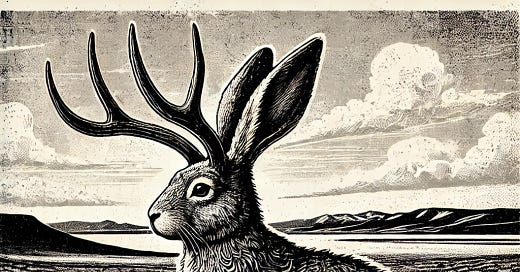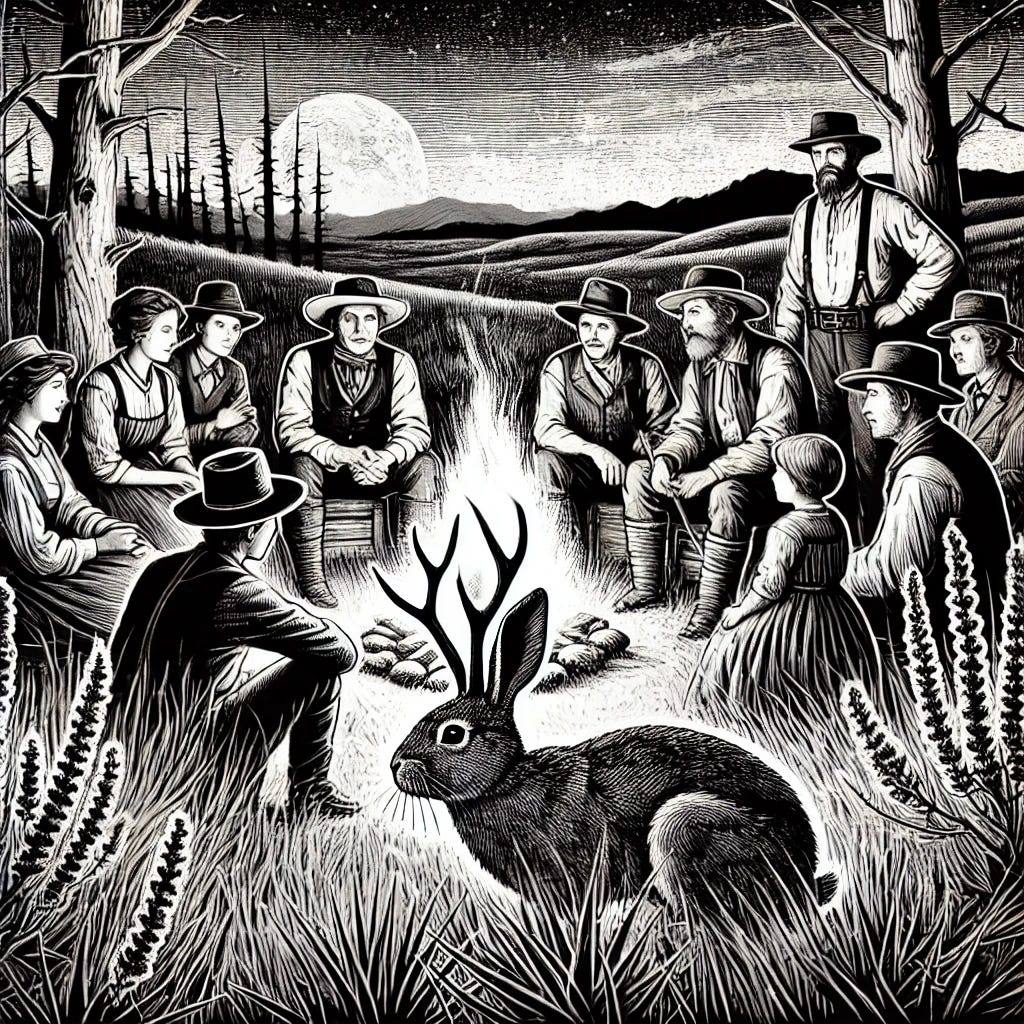Field Notes: We Might Not Have King Arthur, but There's Always the Jackalope
A Wyoming girl's take on American Folklore
Artio Journal’s March theme is “The Quickening,” as we move toward the spring equinox—a celebration of renewal and fertility that’s often symbolized by the hare. Here’s a piece of rabbit-lore from my own western roots.
To this day, the sign outside the gas station in Dubois, Wyoming reads, “World’s Largest Jackalope.” Inside, surrounded by bison jerky and moose-shaped shot glasses, the mighty beast sits on his haunches, lording over his knick knacks. King of the kitschy, ruler of the ridiculous. Yet as a kid I vividly remember this little hut in the middle of my small Wyoming town. We had our very own mythical creature, and we’d caught a giant one at that.
Jackalopes are elusive, as you can imagine. They breed during lightning storms and appear to be nocturnal. They enjoy listening to campfire songs, and some say you can entice them closer with whisky. If you’re lucky, they might even sing along with a tenor accompaniment. The males shed their antlers in the winter, blending in with the regular rabbit population until spring. If you wanted to catch a Jackalope back in the day, it was recommended to wear stovepipes on your legs, to avoid being gored.
There’s magic in believing in the Jackalope, a sense of wonder when you stare out at the plains as if one might be huddled behind a sage brush, just out of sight. Much like the larger tradition of American folklore, where tall tales gave immigrants a sense of awe. These stories helped forge a unique identity, cobbled together to form a new culture in the vastness of the American West.
It’s these myths and legends that help make sense of a place otherwise frightening or strange. My ancestors walked where you might cross the path of a Banshee, or be lured away to the Otherworld by a fairy. Perhaps told to quell the fear of illness, or keep children from wandering too close to a bog—but they grew into legends, spoken in hushed tones, as if truly possible.
Indigenous peoples have shaped their folklore for thousands of years, with stories deeply rooted in the land itself. Legends like the White Buffalo Calf Woman have been passed down for generations, carrying spiritual meaning and guidance. By contrast, American Tall Tales were shaped by immigrants in search of meaning in a new land. Yet all these traditions echo something much older—the deep human need to explain the mysteries of the world through legends.
American folklore is simply a more current iteration- be it the Jackalope, the Mothman, or Bigfoot, these otherworldly beasts seem outlandish, yet it’s part of what makes up the fabric of our shared history. When settlers sat by their fires in the darkness, alone for miles in any direction, these stories became a comfort. They helped channel their fears and anxieties into something wholly new. And today we tread the same pathways a Bigfoot or Jackalope might cross, a sense of possibility, and magic.
The funny thing is, as a kid no one told me the Jackalope wasn’t real. There are so many mounts in Wyoming you’d think people were catching them in their backyards. I remember one in the local Dairy Queen, proudly centered above the window next to the cash register. Children would glance at it as they slurped their blizzards on hot days.
As I grew older I realized it was an inside joke for locals. It was our way of getting back at tourists who flooded the town in the summertime (and often asked questions like “when do the deer turned into elk?”). The embellishments on how to catch Jackalopes added credibility to the story, but the origin of the Jackalope is not nearly as exciting as the myth. Back in 1932, all it took for this piece of Americana to take off was two taxidermist brothers form Douglas, Wyoming, placing a pair of antlers next to a rabbit carcass.
But there are “horned” rabbits, just not in the way you’d imagine. They show up all over the world, documented hundreds of years before the brothers from Douglas decided to create their own chimera. Richard E. Shope, a scientist in the early 1900’s, studied these rabbits, determining it was caused by a virus which created growths, often coming out of their heads. By studying this virus, scientists ultimately created the HPV vaccine- one of the safest, most effective cervical cancer treatments in existence. The vaccine has saved thousands of lives, thanks to, dare I say it, the real-world version of the Jackalope.
It’s a strange full-circle moment—what started as a mythical creature became a key player in modern medicine. But most people simply know the little horned beast from romanticized Americana. In the years since this legend was born, gift shops across the west now supply their own Jackalope stuffed animals, postcards, and yes, giant roadside attractions for tourists to have a little slice of the legend to take home. Yet it’s a symbol I find strangely comforting, a relic of my own family’s journey from the emerald hills of Ireland to rugged Wyoming. Where our stories of banshees and fairies fell away to be replaced with cowboys and Jackalopes. Until we no longer saw ourselves as immigrants, but apart of something new.
I’ve traveled even farther west, to the coast of Oregon. The other day I was walking my dog when I took a detour and glanced over at the quaint houses across the street, when a big grin spread across my face. Someone had attached a Jackalope mount to their front door, centered just above the knocker. This little creature had made it all the way to the Pacific Northwest.
Long ago, they must have migrated and adapted to the rain. The occasional lightning storm giving them a chance to grow. Living just out of sight, as they always have.
Interested in how to incorporate some folklore into your own life? My paid subscribers get access to free resources with tips on celebrating the seasons and inspo on other legends.
Further Reading
This 99% Invisible podcast episode highlights origins of how the legend grew into the iconic western tourist attraction.
Want a deep-dive into the story? Read the book “On the Trail of the Jackalope” by Michael P. Branch.
A fascinating story on the evolution of the “Frontier Theory” from the Smithsonian Magazine.
There’s also some conflict about which is indeed the real “World’s Largest Jackalope” from various spots in Wyoming.
Sources
“The Legend of the Jackalope” City of Douglas Wyoming, [https://www.cityofdouglas.org/255/The-Legend-of-the-Jackalope]
“Wyoming, Where Deer and Jackalope Play” New York Times, [https://www.nytimes.com/1977/11/27/archives/wyoming-where-deer-and-jackalope-play.html]
“The Legend of the White Buffalo Woman” Akta Lakota Museum and Cultural Center, [https://aktalakota.stjo.org/lakota-legends/white-buffalo-woman/
“The Psychological Power of Storytelling” Psychology Today, [https://www.psychologytoday.com/us/blog/positively-media/201101/the-psychological-power-storytelling]






Interesting! I will never again be dismissive of that strange creature who inhabits my world, too. Always showing up in odd places.
i think jackalopes are real.